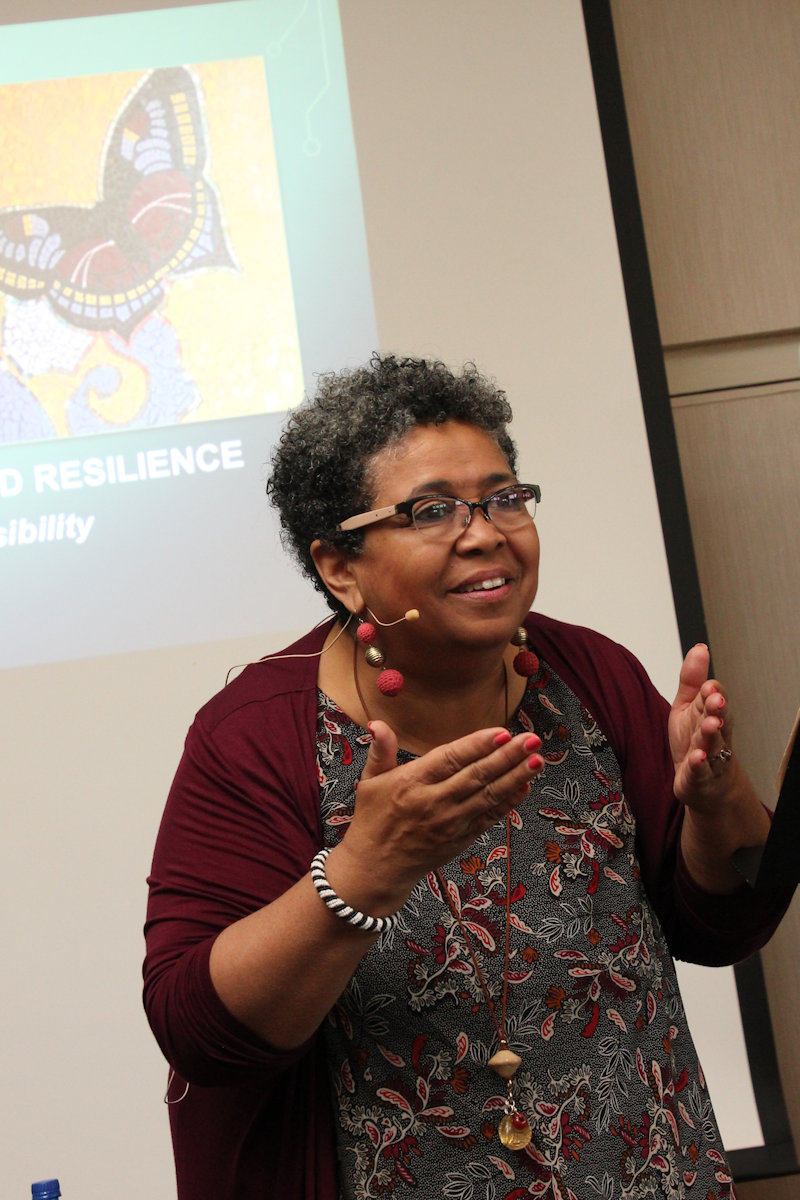 Dr. T delivers the keynote address
Dr. T delivers the keynote address
Conference Keynote
Dr. Tawnya Pettiford-Wates
by Matt Fernald
Dr. T insists that nobody outside her family should call her by her full name, Tawnya Pettiford-Wates. As it happened, this was the simplest of the challenges she laid before CMN in her 2018 conference keynote.
Actor, director, scholar, educator—Dr. T combines it all as founder and director of her Richmond-based theater company, the Conciliation Project. The name arose, she says, because of many Americans’ problematic call for racial reconciliation: “How can you reconcile when you have never conciled?” she asks.
Dr. T speaks with a warm yet incisive tone. “Instead of having a meeting, let’s have a doing. Whenever you sit for a long time, your creative energy goes out your butt!” she preached, to many laughs.
She demonstrated this by having her presentation partner, Dr. Ram Bhagat, play a rhythm on his djembe while we all walked around the room. When the drumming stopped, Dr. T called out a number, and we were to make groups of that number.
We then launched straight in. Dr. T said, “When I look at this group, I see white people.” The energy shifted. “That’s not to say you’re not colorful in many ways. We all have many identities. And it’s still true that when I look, this group is pretty beige.” The energy shifted again; it was the truth, ever complex, and we listened on.
“Is CMN up for change? Why upset the apple cart with change? Change is hard. Change is not comfortable.”
She appealed to us through her experience as a director. “When I coach actors, they tell me what I’m asking them to do artistically is hard. I say ‘Yes, it is hard. AND, you can do it!’
“And so I ask you the central question: What are you willing to give up in order to get what you say you want?
“How do you become a more appealing and inviting organization for folks who do not look like you, or perhaps do not think like you? How does this organization work together to create a more culturally inclusive and racially diverse showing, not only in membership but also in its leadership? How do you increase participation among the Gen-X and Millenial generations?”
How, indeed.
It begins with self-examination. Even good, well-intentioned people can make others feel uncomfortable or unwelcome, we were told. They can even cause trauma: Dr. T shared one moving story of being asked to perform “Pick a Bale of Cotton” for school. When her mother heard her practicing, she was distraught that a music teacher would have black children singing such a song. “My mother was unintentionally traumatized by that experience, and I was traumatized through my mother’s trauma,” Dr. T concluded.
“Here’s the truth: some music needs to go into a museum. If we study it, we study it from a historical perspective, but we don’t teach it to children.
 Dr. T giving keynote
Dr. T giving keynote
“Remember also, not everybody can sing every kind of music. I understand cross-cultural appreciation, but you can get into a deep river doing that, and you need to understand what you’re doing to cross that river safely.”
To illustrate these points, she sang snippets from “The Mexican Hat Dance,” “Ten Little Indians,” and “Dixie Land.” It was a palpable moment.
“Just because things have always been done in a certain way, even with great success, it doesn't mean that it's the right thing to do—especially if the times are changing."
Toward the end, Dr. Bhagat again started up his djembe. We moved around the room and formed groups of five for a discussion activity called “Race Cards.” Each card looked like an oversized playing card, but with racially charged questions that people of color are often asked:
“Can black people get suntans?”
“Should America apologize for slavery?”
“When will the N-word be socially acceptable?”
Each group discussed whether they knew the answer, and whether they’d heard the question before.
Dr. T offered another cross-cultural warning: if we wanted to run this activity ourselves, tread carefully. “You can’t just wade in. As an African-American and female [these questions] have been asked of me all the way from childhood to now.
“Race is not a biological reality, but it is a political reality. My son is an African-American man. When he enters a space, it’s political. When he enters a space, sometimes it’s dangerous to be an African-American man, and he has to know that.
“You all have got to start to explore what whiteness means. What is the power that it has? How is that a barrier to what you want to achieve?”
As we prepared to leave, we were implored once more: Stay woke. “Consciousness needs to be leaned into. It’s not passive. You don’t get away with just being a nice person with good intentions. Sorry,” she said with a friendly shrug.
“It’s a long process, and it’s not going to be comfortable. Sorry again. But you have to think about how long I’ve been uncomfortable. Think about how difficult it might be for some people to enter into white spaces. It’s a real thing.
“I believe this change is possible. If you want to do it, you are just the people to make it happen.”
With that, CMNers moved on to lunch. You could almost hear the thoughts and questions bouncing around in folks’ heads. When they broke out, conversations buzzed through the entire meal—indeed, for the rest of the conference. Dr. T challenged and inspired us all, and shaped a part of CMN’s future.
“The point is to get your work done,” Dr. T urged, “and the work is to change the world.” What CMNer would argue with that?!